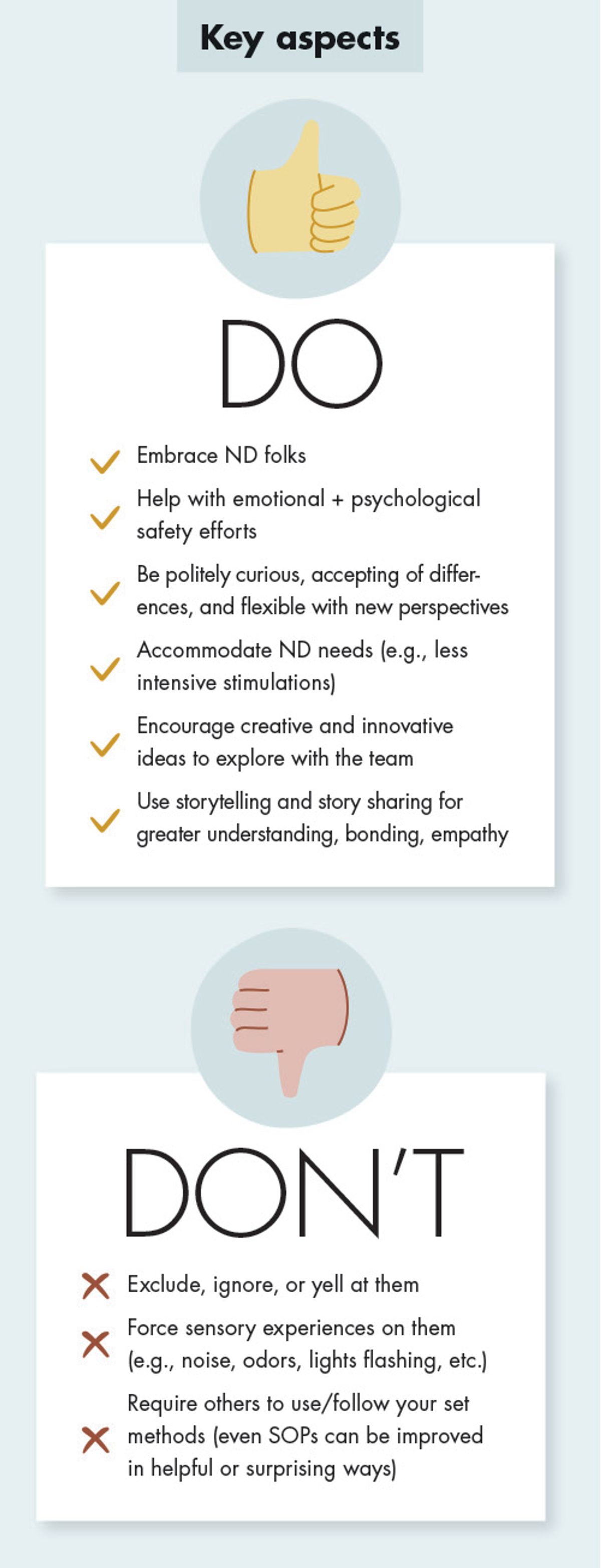Embracing Neurodiversity in the Lab with Psychological and Emotional Safety
Neurodiverse safety staff can play key roles in minimizing risk
Neurodiversity (ND) in labs is a growing topic of discussion. Both STEM and other industries are purposefully hiring ND or autistic folks. I was diagnosed as autistic late in life—just a few years ago. It’s been eye-opening and explains so much of my life. I now empathize with other ND folks and try to help them understand themselves and the role that their neurodiversity plays in their careers.
As an autistic and lab safety professional myself, I’ve come to recognize that, like myriad other industries, labs can benefit from ND staff who focus on safety. Their actions can boost both culture and compliance. But what exactly is neurodiversity, and how can ND individuals leverage their unique strengths to enact positive change in the lab’s safety endeavors?
What is neurodiversity?
ND comprises several differences in cognition, such as ADD/ADHD, autism, dyslexia/dyscalculia/dysgraphia/dyspraxia, PTSD/CPTSD, and Tourette’s. ND people’s brains are wired very differently from those of neurotypical (NT) folks. For example, people ask me, “What’s it like being autistic?” My answer is often, “Imagine you’re a little robot with a very different operating system from all the other little robots.” It’s not what you think; it’s how you think—that is, the brain’s wiring.
This often creates significant challenges for ND people to understand NT people. Autistics, for example, sometimes have trouble understanding allistics (those who are not on the autism spectrum) and vice versa, a phenomenon termed the double-empathy problem. Each type struggles to understand how, what, and why others communicate as they do. Allistics tend to use sarcasm, euphemisms, cliches, and metaphors, which don’t make sense to autistics. Meanwhile, autistics prefer direct, brief, and to-the-point factual discussions without small talk or chit-chat. They may also be monotropic, that is, speaking on a single subject they’re passionate about or prefer to exclusively concentrate on. As a result, I’ve received the criticism, “You talk about risk perceptions and storytelling too much,” several times.
Autistics and NDs see things differently, often in a systematic way not observed as deeply by allistics.
Autism and these other neurodivergences are a disability per the Americans with Disability Act (ADA). However, many people contextualize these neurodiverse ways as a differability. Autistics and NDs see things differently, often in a systematic way that is not observed as deeply by allistics. Some autism researchers have postulated that autism drives innovation and inventions. This drive to innovate new systems that are more effective at reducing risk can be a boon to our collective safety culture.
Because the ND are often a marginalized minority, they crave agency, a voice to guide the ND conversation and programs at workplaces. A common and logical saying is, “Nothing about us without us.” In other words, don’t try to create programs or initiatives to benefit ND folks unless you have the meaningful help of those ND folks. Think about it—how can allistics really understand autistics? But including ND individuals requires an environment of emotional safety.
Emotional safety
In the ND context, emotional safety can be thought of as being able to and bringing one’s true self to work. Most ND folks just want to be accepted as their true selves. But society punishes those outside of what NTs consider “the norm.” So, they learn to mask or hide their true selves and display speech and mannerisms they perceive as fitting in. Indeed, despite producing quality work, I’ve been told, “Jon, you’re not a good fit—you’re a square peg in a round hole.”
Labs can and should encourage and facilitate emotional safety. A way to start is with shared one-on-one stories about our collective ND. Stories with emotional impacts help us to relate and bond. We can publicly describe our pro-ND feelings. Since my diagnosis, I’ve gotten more and more comfortable openly discussing autism and my experiences with it. I’ve even done some public talks about being autistic and working in safety and risk. These always beget private conversations with attendees who wish to discuss it more. Mutual vulnerability is a portal to closer relationships and friendships. This shared culture of storytelling can lead to a greater culture of emotional safety.

Being unmasked allows ND people to thrive at work and in life, whereas always having to mask puts them in a survival mode. And in the case of communication between autistics and allistics, the dreaded double-empathy problem obviously contributes to this wicked problem. An inability to understand and relate to communication styles creates challenges. One solution is summed up in a helpful quote: “Acceptance is a gift we give ourselves.” This brings us to a complementary concept—psychological safety.
Psychological safety
While emotional safety is being able to be oneself without repercussions, psychological safety is being able to freely share ideas without repercussions. If one feels totally safe in doing so without concerns for negative consequences, they’re a better team contributor and the whole lab benefits.
It’s hard to be effective if you experience negatives from workmates or managers. Imagine if you experience being:
- Ignored (talked over)
- Dismissed (no response and topic changed)
- Shot down (verbal or paraverbal reaction like a snort of derision)
- Excluded (not invited to meetings where your expertise could contribute)
- Made to feel stupid (laughed at)
- Getting sarcastic or caustic responses (often heard as if literally meant)
How can you foster greater psychological safety? Being open to new ideas (i.e., cognitive flexibility) can facilitate innovation of the team’s habits. Curiosity about others' ideas, no matter how odd, and expressed with sincerity helps. Make it part of everyday conversations. Little bits demonstrated regularly add up to much more than a single statement or discussion about its importance. And be flexible with new perspectives or innovative ideas. In the words of advice columnist Carolyn Hax, “Flexibility is so important it deserves a seat at the table.” In terms of safety and risk, flexibility of thought might just prevent an unfortunate incident. Let’s examine a few examples.
The benefits of NDs in safety/risk roles
Here are ways that some NDs can contribute to safety roles in a way that leverages their talents as taken from my autistic experiences, specifically:
- Creativity: Designing a fun safety culture game at a wellness fair.
- Innovation: Designing lab safety and training apps with computer science dev teams.
- Outside-the-box flexible thinking: A biomedical engineering research team needs to one-hand recap needles and get the biosafety officer to willingly agree to the unconventional but safe procedure.
- Deep dives into topics: Learning the research on risk perceptions and excitedly sharing it with peers at conferences.
- Hyper-focus: Spending eight hours a day for months doing data validation of a Superfund site (at least I was 100 percent billable as a consultant).
- Logical, less emotional: If external checklist inspections aren’t improving safety culture or compliance, then alternatives are well worth exploring.
Besides those benefits, NDs commonly have unique traits that can have positive effects on their safety/risk work. For instance, they can be great decision-makers. They’re more likely to base it on data with purpose and logic. Often, they strive to be effective and are less swayed by subjectivity or emotions. Also, they’re far less likely to engage in victim blaming and more likely to point toward management processes as a cause.
Similarly, during incident investigations, NDs often use objective, scientific techniques and exhibit a helpful calmness. They might be less emotional and follow a more step-by-step logical sequencing. They often support the beneficial approach of “No blaming, no shaming.” They’re naturally attuned to use the “Five Whys” method of risk assessing and root cause analysis, employing a “patient, persistent process of prodding.”
Final messages:
Neurodiverse teams perform better, are more effective, and innovate more. If you enable and support them as part of your safety group, they bring many benefits. Emotional safety allows us all to be ourselves and bring who we are to our teams. Psychological safety is strongly associated with effective and high-achieving teams (like the US Navy Seals and other similar highest-stakes and risk teams). Remember, safety is for everyone—physical, emotional, and psychological.



